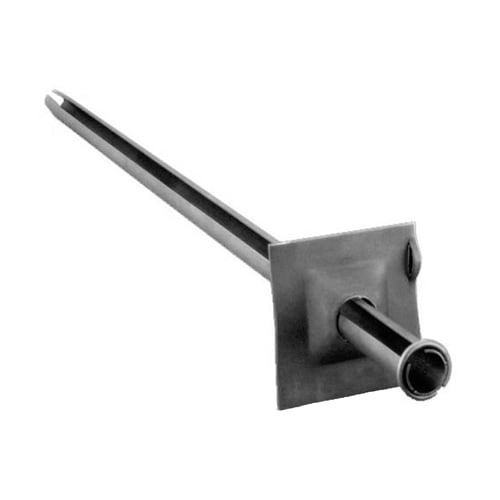Friction Stabilizers

The following are items to be aware of when using/installing friction stabilizers:
Type of Ground - The nature of the ground must be evaluated. Soft strata requires a longer anchorage length to be effective. Soft ground results in larger hole sizes for a given bit size (due to bit rattling and reaming).
Scaling - The ground should be thoroughly scaled (i.e. barred down) before drilling and bolting. Periodic re-scaling may be required while drilling.
Strength and Yield Capacity of Bolt -The mechanical properties of the bolt should be appropriate for the ground conditions, bolt length and bolting pattern. Pull tests should be performed to determine initial anchorage of the friction bolts.
Proper Grade Plates - Thin or weak plates will deform at low bolt tension. The bolt could also rip through the plate during installation or by bolt loading. Plates should meet ASTM F432 specs.
Hole Condition - The hole should be cleaned and examined to ensure the friction bolt will insert smoothly. Variation in hole diameters (due to differing strengths of rock strata or excessively fragmented ground) can yield variations in anchorage capacities at various elevations.
Hole Length - If holes are drilled too short then the bolt will stick out of the hole and the plate will not make contact with the rock surface. Damage to the bolt will result if an attempt is made to drive the bolt further than the hole length will permit. The hole should thus be a few inches deeper than the bolt length being used.
Oversize Holes - The hole size required for the friction stabilizer is the most crucial aspect of the installation. The holding power of the bolt relies on the fact that the hole is smaller than the diameter of the bolt. The larger the hole relative to the bolt diameter, the less the holding force (at least initially).
Oversized holes can be caused by using the wrong bit size, leaving the drill running while flushing the hole, soft ground (faults, gouge, etc.) and bent steel.
Undersize Holes - If the hole size is too small relative to the friction size then it becomes extremely difficult to install the bolt. The bolt can be damaged i.e. kinked or bent when installed. Undersized holes are usually caused by worn bits and/or wrong bit sizes being used. If integral steel is used with a stoper or jackleg, the hole diameter decreases with each change of steel (normal practice requires smaller bits be used as one drills deeper into the hole). With each reduction in hole diameter the anchorage capacity increases. Integral steel often results in crooked holes and should be avoided whenever possible.
Drive Times - For a typical 5 or 6 foot friction bolt, a stoper or jackleg will drive the bolt into the hole in 8 to 15 seconds. This drive time corresponds to proper initial anchorages of the stabilizer. Faster drive times should serve as a warning that the hole size is too large and thus the initial anchorage of the bolt will be too low. Longer drive times indicate smaller holes sizes probably caused by bit wear.
Bit Selection - Button bits are commonly up to 2.5mm larger than their slated size. A 37mm button bit may in reality be 39.5mm in diameter when new. This is too large for an SS- 39 friction. Button bits do wear quickly however, increasing anchorage capacity and increasing drive times. Cross or "X" bits, on the other hand, are sized true to stamped size usually within 0.03". They hold their gauge very well but tend to drill slower than button bits. They are preferable to button bits for friction installation where possible.
Perpendicular Installation - Bolts should be installed as near perpendicular to the rock surface as possible. This ensures the welded ring is in contact with the plate all round. Bolts not perpendicular to the plate and rock surface will result in the ring being loaded at a point which may cause early failure. Unlike other rock bolts, spherical seat washers are not available to correct for angularity with frictional stabilizers.
Installation Driver Tools - Driver tools must transfer percussive energy to the bolt during installing, not rotational energy. This is opposite to most other forms of ground support. The shank end of the driver must be the proper length to contact the drill piston in stopers and jacklegs (i.e. 41/4" long for 7/8" hex drill steel). The shank end on the drivers is round so as to not engage the rotation of the drill. The driver tools must have the proper end shape to fit into the friction without binding and causing damage to bolt during installation.
Education - Proper education of mining personnel and supervisors is mandatory. As manpower turnover is relatively frequent in bolting crews, education must be continuous. An informed workforce will save money in the long run.
Monitoring - Installation must be monitored to ensure proper procedures and quality are maintained. Pull-test measurements should be routinely conducted on friction stabilizers to check initial anchorage values.




